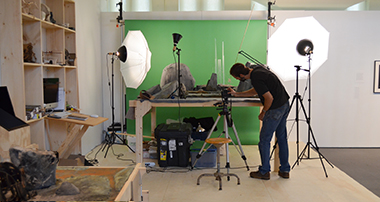Perfectly Futuristic
 |
|
Alumnus Colin C. Boyd, MFA '08, offers museum goers the opportunity to see an artist in action. (Photo, courtesy University Art Museum) |
ALBANY, N.Y. (August 22, 2016) – The Future Perfect exhibition, on display at the University Art Museum through the fall semester, shakes things up.
In the works of more than 20 visual artists, nature and man’s impact on nature are juxtaposed in new and unsettling ways. Future Perfect features artwork that explores our conflicted relationship with the natural world and informs how we view the past, how we perceive the present, and how we imagine the future.
The exhibition is co-curated by Danny Goodwin, associate professor of Art and Art History, Janet Riker, director, and Corinna Ripps Schaming, associate director and curator of the University Art Museum.
On Saturdays this fall, visitors will be able to see an artist at work. Alumnus Colin C. Boyd, MFA ’08, will be in the museum, creating a stop-action sculpture animated film.
“I’ll be manipulating the sculpture as I am creating the film,” Boyd said. “It’s kind of a post-human history narrative, an interpretation of the future based on a mix of knowing and not knowing.”
He creates small creatures modeled after those that are on the verge of extinction, like the American bison or the California condor, and creates a short trailer each week of these creatures walking on artificial legs.
Boyd kicks off an extensive calendar of related programming with a talk at the museum on Sept. 6 at 7 p.m. Over the fall semester, the museum will host weekly public programs, including performances, readings and informal conversations related to the subject of climate change within a broad scientific, literary, historical and geo-political framework.
Elsewhere in the museum, there are themes that make you wonder: What will nature look like in 500 years? How do climate change and man’s use of the environment alter nature irrevocably?
A work by Neal Slavin, for example, shows a group of Top Product Managers (1979) in white shirts. Positioned below that print is a photo of rangers lined up in uniform at the Grand Canyon National Park (1979).
Nature photos by Edward Steichen (Venerable Tree Trunk, 1932) and (Lotus, 1915) evoke a peaceful quality. Just below them are Alison Hunter’s Port of Albany #1 and #2, showing man’s influence.
Intriguing sculptures like Amy Brener’s Chopper, Stro and Recliners radiate a nature-like greenish glow. They are labeled “totemic structures of an imagined future.” Made of pigmented resin and glass, they are embedded with microchips, circuit board, and batteries, “preserving” these for the future.
And Jason Middlebrook’s painting on logs (Planks, 2014) reclaimed from submersion in Georgia’s Savannah River creates a tension between something organic and something manmade. He simply looks at the “interfaces between human actions and the environment.”
Future Perfect: Picturing the Anthropocene is on display through Dec. 12. More information is available on the University Art Museum website.
The Anthropocene Web Project is an online resource that gives breadth to the exhibition. This website will include a schedule of public programming, academic papers, bibliography, on-line discussions and links to related sites of global, national and community organizations.
The Liddle Gallery features a study area including a selection of exhibition related books and periodicals provided by the University Libraries.
Funding for the exhibition, publication and programming is provided by UAlbany’s Office of the President and Office of the Provost, The University at Albany Foundation, The Presidential Initiatives Fund for Research and Scholarship (PIFRS), the University Art Museum Endowed Director’s Fund, the Ann C. Mataraso Endowment Fund in honor of Professor Emeritus Mark Greenwold, University Auxiliary Services, and the Ellsworth Kelly Foundation.
![]() For more news, subscribe to UAlbany's RSS headline feeds
For more news, subscribe to UAlbany's RSS headline feeds
A comprehensive public research university, the University at Albany-SUNY offers more than 120 undergraduate majors and minors and 125 master's, doctoral and graduate certificate programs. UAlbany is a leader among all New York State colleges and universities in such diverse fields as atmospheric and environmental sciences, business, education, public health,health sciences, criminal justice, emergency preparedness, engineering and applied sciences, informatics, public administration, social welfare and sociology, taught by an extensive roster of faculty experts. It also offers expanded academic and research opportunities for students through an affiliation with Albany Law School. With a curriculum enhanced by 600 study-abroad opportunities, UAlbany launches great careers.


